

Air : Preschool Science Experiments, Lessons and Activities. Understanding the Science of Air Overview: Teaching children about air can be a difficult task since air is relatively invisible.
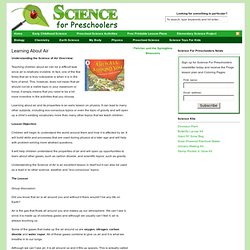
In fact, one of the few times that air is truly noticeable is when it is in the form of wind. This, however, does not mean that air should not be a viable topic in your classroom or home; it simply means that you need to be a bit more inventive in the activities that you choose. Learning about air and its properties is an early lesson on physics. It can lead to many other subjects, including eco-conscious topics or even the topic of gravity and will open up a child’s existing vocabulary more than many other topics that we teach children.
Lesson Objective: Children will begin to understand the world around them and how it is affected by air. It will help children understand the properties of air and will open up opportunities to learn about other gases, such as carbon dioxide, and scientific topics, such as gravity. The Lesson Group discussion: by Franklyn M. Hotmail - adie80. What's Here for Museum Professionals? Make: Kids. Design for kids and the home. Chapter 2: Electromagnetism. iGoogle. Build a Website - Create a Blog. How to make a miniature zoetrope. Here is quick and easy way to make a fully functional miniature zoetrope.

You can put this together in half an hour (plus paint drying time) out of easy-to-find materials. I made this one out of an empty Ovaltine container. Materials Cardboard Ovaltine can or similar cylindrical food container. Grits, corn meal, and oats often come in this type of container. Steps Cut out the two template pieces with the notches and tape them together to form one long strip. Notes You do not have to have the same number of images as you have slits. Comments. Eco Crafts For Kids. Ask a Physicist Answers. Please see link for complete demonstration and question.

Picture courtesy of Atoma Figure courtesy of RJ Hall To help this physics teacher "get it," a physics phenomenon known as the index of refraction must be explained. You may have heard the word refraction before. Chemistry Fun with Pennies. Use pennies, nails, and a few simple household ingredients to explore some of the properties of metals: Materials 20-30 dull pennies 1/4 cup white vinegar (dilute acetic acid) 1 teaspoon salt (NaCl) 1 shallow, clear glass or plastic bowl (not metal) 1-2 clean steel screws or nails water measuring spoons paper towels Shiny Clean Pennies Pour the salt and vinegar into the bowl.
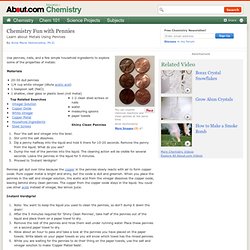
Stir until the salt dissolves. Pennies get dull over time because the copper in the pennies slowly reacts with air to form copper oxide. Bottle Light Bulb AKA Bacardi Bulb. The Kitchen Pantry Scientist. Paper airplane - The best paper airplane - How to build it -1- Build the best paper airplane in the world!
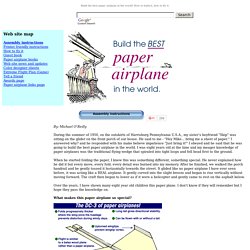
How to build it, how to fly it. | Assembly instructions - How to build it| Printer friendly instructions| |How to fly it | Awards page | Top of page | Visit the Paper Airplane Guest book and leave your message.Paper Airplane links page.Airplane Hall of Fame - The DC-3 and nine other aircraft that changed aviation. Welcome! — Science@home.
If you’re here then you managed to find me through Twitter or Facebook or found the sign saying ‘Start Here!’
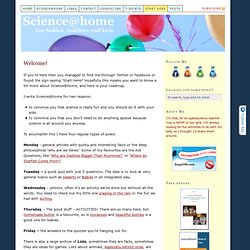
Hopefully this means you want to know a bit more about Science@home, and here is your roadmap. I write Science@home for two reasons: to convince you that science is really fun and you should do it with your kids.to convince you that you don’t need to do anything special because science is all around you anyway. To accomplish this I have four regular types of posts: Monday - general articles with quirky and interesting facts or the deep philosophical ‘why are we heres.’ Tuesday – a quick quiz with just 5 questions. Wednesday – photos, often it’s an activity we’ve done but without all the words. Thursday – The good stuff – ACTIVITIES! Friday – the answers to the quizzes you’re hanging out for. There is also a large archive of Lists, sometimes they are facts, sometimes they are ideas for games. There are extra posts that sneak in here and there as well, but that’s the usual setup.
Kids Magazine > Features for kids > Nikola Tesla - Unsung Prophet of Electrical Age. Pitara Kids Home > Magazine > Features for kids By B Sumangal; Illustration by Shiju George Look up fluorescent bulb, neon lights, car ignition system, electron microscope, microwave oven and many others - you can search page after page but your search will turn up zilch on Tesla in any normal reference book.
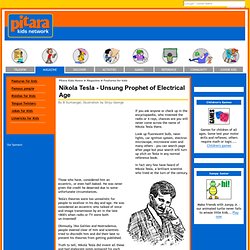
Educators. Lemonade by Laura Lamond. Edible Science Projects - Science Projects You Can Eat. How to Make Floam. Floam™ is like slime with polystyrene beads in it, that kids can mold into shapes.
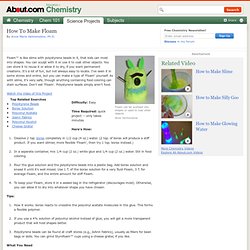
Flubber Recipe - Make Metamucil Flubber. Disappearing Ink Materials. How to Make a Three-Pendulum Rotary Harmonograph. A harmonograph is a mechanical device that uses swinging pendulums to draw pictures, believed to be originally invented in 1844 by Scottish mathematician Hugh Blackburn.
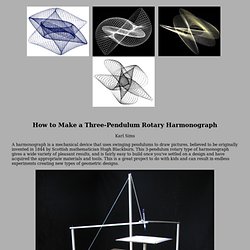
Ferrofluid Fun. 900,000 volt Van de Graaff Generator Using Cheap Parts. Lets build a 500,000+ volt Van de Graaff generator!!

I built this one in about a week, using scrap parts from a sewing machine and materials ordered from I have seen the larger machines in operation at my local science museum and this one does just as well. I have made hair stand on end and even pie pans float up and off the machine. Van de Graaff. Van de Graaff Generator March 21st, 2009 Mark Rehorst When I was a kid I had a very small Van de Graaff generator (VDG) and it was a lot of fun. I always wanted a larger one but never got around to making one until Alex told me about someone bringing one to school and demonstrating it in his class. Then I was at an Ikea store and saw those bowls and the decision was made for me - it was time to build one! Click small images to see larger, more detailed images. I originally built the generator with a positively charged sphere, as shown in the photos and plans on this page. 25 Superb Optical Illusions For Kids. An optical illusion (also called a visual illusion) is characterized by visually perceived images that differ from objective reality.
The information gathered by the eye is processed in the brain to give a perception that does not tally with a physical measurement of the stimulus source. There are three main types: literal optical illusions that create images that are different from the objects that make them, physiological ones that are the effects on the eyes and brain of excessive stimulation of a specific type (brightness, color, size, position, tilt, movement), and cognitive illusions, the result of unconscious inferences. Source Wikipedia. These optical illusions for kids help them in increasing concentration power and sharpen their focus. Though these optical illusions are for kids, we are sure that adults will enjoy them, as well.
Advertisement Pink Dots If your eyes follow the movement of the rotating pink dot, the dots will remain only one color, pink. Bird in the bush. Kids Home Page. Fun Visual Tricks & Optical Illusions. Diet Coke + Mentos.